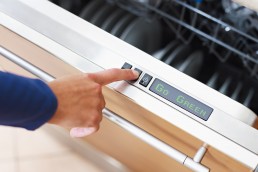Dryer Preventative Maintenance
 Dryer maintenance is easy! Follow these tips to keep your dryer running smoothly and without error.
Dryer maintenance is easy! Follow these tips to keep your dryer running smoothly and without error.
Clean the Lint Screen Before Each Load
It says so on a lot of dryer filters nowadays, but it's still a mistake we see many people make. In addition to the lint screen, the dryer vent tube and household dryer duct should be cleaned once every year or two. Keeping the vent duct clear helps maintain a strong airflow and decreases the rate at which dryer lint can collect within the machine cabinet.
Lint building up in the machine cabinet decreases its efficiency but it also increases the potential fire hazard of the dryer. Lint collecting in the dryer cabinet or even the household duct work can lead to blown thermostats and thermal fuses. Dryer lint will clog the moving components like the drum rollers and idler pulley and the machine will begin and squeak and squeal. Run a dryer that way for too long and larger problems will surface.

Dryers with restricted air passages need longer run times for the same effective dryness. Many “long dry time” complaints are traced back to a restricted dryer vent duct. Sometimes the restriction is just in the dryer vent tube found behind the unit. However, I’ve found restrictions from the machine blower wheel to the screen on the very end of the household dryer duct. Clean the lint screen regularly before your dryer builds up an excess of lint.
It is for this reason I recommend using just one dryer sheet per dry cycle. If you prefer, you can eliminate the use of dryer sheets all together and use Dryer Lint Balls instead. Lint Balls can be found at most department stores. Dryer sheets can be sucked into the machine air duct during operation and clog the air blower wheel and using multiple dryer sheets in any one cycle makes it easier for the sheets to escape the dryer drum into the blower housing. When the blower wheel becomes obstructed the dryer makes a very loud humming and vibration noise. A stuck dryer sheet can produce this noise as can a buildup of lint on the blower wheel assembly, lint that builds up because it cannot exist the machine effectively.
Lint Balls can be found at most department stores. Dryer sheets can be sucked into the machine air duct during operation and clog the air blower wheel and using multiple dryer sheets in any one cycle makes it easier for the sheets to escape the dryer drum into the blower housing. When the blower wheel becomes obstructed the dryer makes a very loud humming and vibration noise. A stuck dryer sheet can produce this noise as can a buildup of lint on the blower wheel assembly, lint that builds up because it cannot exist the machine effectively.
Air flow is really the most important factor in the operation of a dryer. A dryer with no heat production can still dry clothes so long as there is sufficient air flow to remove the moist air from the system. Running a dryer without a heating element is inefficient and the dryer will need a long time to complete the task, but it will dry.
Don't Overload the Dryer
Another tip to keep your dryer working better for longer, don’t overload the dryer. Overloading a dryer contributes to long dry times due to the restricted amount of airflow within the dryer drum. Because the dryer drum’s volume is taken to capacity, the clothing items don’t have enough room to move about the drum and the air within the drum has a harder time escaping the dryer via the machine air duct.
Overloading the dryer can also put greater stress on the dryer drum rollers, flattening them down and causing a very loud thumbing noise during machine operation, kind of like the sound a flat tire makes. If allowed to persist, the drum rollers can eventually break and the roller bearing can warp, greatly increasing the cost of a repair.
They don’t make any appliances the way they use to. A fellow technician named Dave (a 28-year Pro and my Primary Trainer) had a customer with a 12-year-old Kenmore dryer that stopped heating. Dave discovered the heating element and thermostat had blown. The heating element broke because of increased heat stress from operating the dryer with virtually 0% air flow. Dave’s customer had not cleaned the machine lint filter since they bought the machine nearly 12 years prior. They had no idea it was there and that they were suppose to remove and clean it after every cycle, no one ever told them as much.
I asked Dave, “did you tell them to get the air duct cleaned out?” Laughing Dave said, “Uhhh yeah!”
Nowadays many modern dryers have sensors that measure the rate of air flow through the machine. If the air flow reading drops below an optimum level the machine is designed to shutdown heat production. In some models, all motor movement will cease in the event of a restricted air flow fault! Another tip, a dryer vent duct should rise no more than eight feet above the machine and should run no more than 15 feet to the outside of the home and the duct should not have more than one 90 degree turn. I’ve seen long air ducts cause an air flow error even though the air duct was perfectly clear.
 Vacuum the dryer cabinet and blower wheel housing. The condition of the dryer cabinet is a good indication of the air flow. A dryer with thick layers of dust within the machine cabinet and no obvious machine duct break is having a serious airflow problem. The wet dusty air is being returned back into the machine. Removing the dust buildup also helps maintain the machine moving parts like the motor, idler pulley and rollers which can be restricted with the lint dust adding friction to the system which will eventually break the affected components.
Vacuum the dryer cabinet and blower wheel housing. The condition of the dryer cabinet is a good indication of the air flow. A dryer with thick layers of dust within the machine cabinet and no obvious machine duct break is having a serious airflow problem. The wet dusty air is being returned back into the machine. Removing the dust buildup also helps maintain the machine moving parts like the motor, idler pulley and rollers which can be restricted with the lint dust adding friction to the system which will eventually break the affected components.
Need Help Troubleshooting Your Dryer?
Make an appointment for guidance in troubleshooting your dryer’s heating problems and online assistance in conducting your own preventative maintenance procedures. Check back often for more articles on the Importance of General Maintenance and Preventative Maintenance Tips.
Thanks for reading, and give us feedback, we love hearing from you!

Maytag is my Favorite Appliance Brand
As an in-home appliance repair technician, you develop preferences for certain brands over others. My preferences are based on the general difficulty level of repairs in my experience. The success rate of those repairs and the typical repair costs are contributing factors. Also, there is the potential for increased longevity of the machine due to the repair. Last but most important of all are my customer’s reviews. Customer reviews are important to me. They are the biggest contributing factor in my opinion of the Maytag product line. People generally love their Maytag machines and recommend them highly. Maytag owners buy appliance repairs, and many will gladly buy expensive, major, overhaul type repairs if it means they’ll get to keep their beloved Maytag appliance for another five years or so.

In my opinion as an appliance technician the Maytag product line is one of the best you can buy for your buck, meaning Maytag’s are strong valve buys. I think Maytag appliances give their owners some of the best value for the money. There are residential refrigerators on the market that can cost as much as $15,000. Some of the high-end appliances can be very well built with good engineering concepts and tons of ingenious features. They can operate efficiently for 15 years and leave their customers feeling satisfied with the overall life span and performance of the machine. The only problem being the $15,000 cost.
Maytag products are typically very well-built machines. The designs are sturdy and the parts are solid. Once, I disassembled an in-warranty Frigidaire laundry center according to procedure. After removing the top panel screws, I watched as the sheet metal casing crumbled and fell in on itself due to the pressure of its own weight. My customer, who was in the room with me at the time asked “is it supposed to do that?” I answered simply “nope.” I don’t see that kind of thing with Maytag products. When I disassemble and repair a Maytag product, I can see and feel the craftsmanship that went into the manufacturing of the product. Because of Maytag’s engineering, repair procedures for their appliances are more intuitive for a qualified technician, making repairs relatively simple, quick, and cost effective compared to some other brands.
Maytag makes good solid parts and engineers its appliance products with standard SAE sized components like nuts and bolts. Standardization lends itself to more commonalities across different types and models of appliance machines making it possible to repair Maytag’s with cheaper generic replacement parts. There are manufacturers in the market that will make a component like a mounting bolt for a motor specific to that brand and model! When I’m repairing a Maytag product and a mistake happens at the parts warehouse, some essential components like the nuts and bolts are left out of the parts package. I don’t worry because everything I need to make a successful repair happen is probably in my spare parts bag. If I should come up short, no worries, I’ll just fly over to the nearest corner hardware store and get a pack of 5/16 Hexagonal screws and finish the job same day. I’ve run into these kinds of problems with brands like Miele, LG or Bosch and had to reorder something like one cap, one screw or one bolt. I had to order this one thing specifically and directly from the manufacturer and wait for delivery. One manufacturer gave me an indefinite ETA for a plastic dryer screen part. A simple enough component should have been generic and readily available, at least at an appliance parts distributor. I asked tem “what does indefinite ETA really mean?” Their reply was “I’ve seen this kind of order take up to six months to fulfill.” Imagine that, a six-month waiting period to complete a 5-minute job!
Maytag has some of the best engineering in terms of keeping the technician in mind. Mechanical systems breakdown eventually, it inevitable. Maytag’s seem to be built with this understanding. Critical system components, which require more frequent servicing, are made easily accessible. Maytag’s tend to have more screws, clamps, and panels so that an experienced technician can make several critical repairs without a total disassembly of the machine or having to pull a machine from the wall to get in through the back. This can allow homeowners, with the assistance of a Neli technician, to perform many repairs themselves.
I’ve had representatives from other manufacturers tell me they’ve changed their designs, going against the repair advice of hundreds of technicians over several years in favor for a more streamlined look. “But Mr. Rep, how will we replace those troublesome fan motors in the back of the appliance, or the pumps in the far bottom right corner?” Rep says, “We’re confident these machines won’t fail.” Won’t fail ever??? Good luck with that one, I say. Not only are Maytag’s engineered with repairs in mind, they’re just as slick and streamlined as any other product in the market, and they look just as good as any other medium and even high-end priced product.
Maytag products have longevity. My customers report problems starting with their Maytag’s toward the end of a standard life expectancy. In the field, you do not really have to sell Maytag repairs because they sell themselves. Maytag customers want their appliances fixed. I’ve repaired lots of 25-year-old Maytag appliances against my own advice! “Are you sure you want to fix this thing. I mean It’s 25-years-old and I’m charging you $400 to repair it. For $400 you can get a new machine of almost any brand you want!” These customers reply, “It has really been a great machine, forget about the money, if it’s worth fixing in your opinion as a repairman then I’d rather put the $400 into my Maytag.” “You got it!” I’ll say. I’ve worked on and fixed 30 Maytag washers, I’ve had two customers that had working 40 to 50-year-old Maytag appliances in their homes. These customers are keeping their Maytag’s as collectors’ items and all they ever seem to need is a little maintenance from time to time. I’ve never met any Frigidaire or Samsung collectors. I’m just saying.
I hope you enjoyed this article, be certain to check out Neli’s blog page for more articles like this one!
Refrigerator and Ice Maker Preventative Maintenance
The Fridge

When I visit a home for a refrigerator problem many of my customers will comment, “the fridge used to last 20 years no problem.” Personally, the only refrigerator maintenance I remember doing growing up was spring cleaning. Wiping up all those juice spills in the cabinet and the smudgy fingerprints on the front of the door. Today’s modern refrigerator requires regular maintenance to maintain performance. The average refrigerator can last between 12 and 14 years, but regular maintenance is absolutely required for pretty much all modern refrigerators to even come close to lasting that long. Most refrigerators are equipped with an owner’s manual which provides use and care tips, and some have an outline of a scheduled maintenance routine.
Airflow is very important for a refrigerator. Like water for a fish, a refrigerator needs free flowing air channels to cool properly. Many refrigerator problems are traced back to a fault in the air flow of the refrigeration system. First tip, clean your refrigerator regularly. A colleague of mine named Jim once found a refrigerator wasn’t cooling properly because a half-eaten, left-over block of cheese had fallen off the back of a shelf and lodged itself inside the cold air return duct. The customer hadn’t done anything wrong, Jim was removing items from the fridge and taking down the shelves to continue his troubleshooting when he happened to notice something weird in the duct, shinned his flashlight at the area and found the lodged block of cheese. This tech story is a good example of the importance of regular cleanings as a preventative maintenance measure. I also tell my customers to wipe the door seals on occasion to clear obstructions and remove corrosive debris and keep the seals nimble and fresh.
Tip two, service the condenser coils at least once a year. This procedure should be done twice a year if you have a lot of fury pets. Pet hair tends to be very thick and when it collects on the condenser coils of your refrigerator they act as a net helping dust collect with greater frequency and density. A clogged condenser coil restricts the heat transfer process of the refrigeration system making efficient cooling more difficult. Allowed to persist, a refrigerator operating under these conditions will apply greater heat stress and pressure to heat sensitive mechanical and electronic components.

Many poorly cooling refrigerator complaints stem from clogged and dirty condenser coils. The first step in diagnosing a sealed system problem in a poorly cooling refrigerator is to clean the condenser coil if it is clogged. Should you have trouble identifying your refrigerators condenser coil or need an effective method to clean the condenser coil thoroughly visit TinLizzee.com to chat with experienced in-home appliance technicians who have unique solutions for all appliance related problems!
The Ice Machine
Standalone ice machines require regular maintenance as well. Ice makers are very similar to refrigeration systems so the regular maintenance needs are the same. Regular cleaning of the interior, door seal and condenser coil go a long way in preserving the longevity of the machine. Continuous ice production lends itself to lime scale buildup throughout these units. The circulation pump in an ice machine should be treated for scale buildup removal about once a year to maintain the ice machine’s production efficiency and quality of ice cubes. Most customers prefer to pay a technician for routine maintenance service on their ice machines because the procedures can be detailed and tedious. 
Visit Neli.com for guidance in troubleshooting your refrigerator and ice maker cooling problems and online assistance in conducting your own preventative maintenance procedures. Check back often for more articles on The Importance of General Maintenance and Preventative Maintenance Tips which can be found on the TinLizzee.com blog page. There you can find not only this article but also interesting information about most aspects of appliances, from how to keep them looking their best to which ones NOT to buy. Thanks for reading, and give us feedback, we love hearing from you!
The Importance of General Maintenance

Performing general maintenance on a routine schedule can go a long way to ensure the longevity of your household appliances. At Neli experienced qualified appliance technicians will walk you through performing your own preventative maintenance check-up on all your appliances. For only $19.99 you can help your machine run strong for a longer time frame, that is a $120 value for about the cost of a large pizza! In addition, preventative maintenance checks can save you from the potential nightmare of major damages to your home due to a faulty appliance.
Quick story, one day I had a customer who owns a small hotel. He ordered a repair for a dryer that wouldn’t heat. The heating problem was a relatively easy fix and I finished the repair quickly, freeing up more time for me to be extra helpful for my customer. I offered to conduct a maintenance check-up on the washing machine. The washer was a good, older model machine and hey, it sits right next to the dryer so why not right! I’m a great technician so my customer was more than happy to pay additional fees for a little piece of mind on the washer, especially after already paying me around $250 to fix a broken dryer. I conducted the preventative maintenance check-up of the washer and when I tilled the machine to check the motor windings and transmission cam, I found a very slow leak coming from the drain pump. The leak was so slow it took about ten minutes to verify. The leak rate was slow enough that no matter what my customer was washing, there would not be enough water leaked at any one time to spill out from underneath the machine where anyone passing by would see it. The water leak was also consistent enough to cause some water damage to the flooring underneath the washer. The floor was not level and slightly slopped to the rear of the machine and after what looked like years of leaking, the water had eaten away at the flooring causing the floor to concave into a kind of bowl directly underneath the washer allowing the leaking water to pool. It was a good thing I caught it when I did because on the lower floor, below the washer was a hotel room. My customer was so very glad I went the extra mile to offer additional services. I was able to repair the unit that morning and saved my customer from the heartache of a collapsed floor that could drain into the subfloor and the units below.
Always check your owner’s manual. Most of my customers are surprised at the wealth of information within the owner’s manual. I am a General Appliance Technician, or Generalist for short. I cannot possibly remember every minute detail of every appliance product on the market, and given this industry is a business of details, its an irrational task to try to achieve. Often times when customers ask me questions very specific to their machine, I will ask them; “do you have your owner’s manual?” their eyes get wide, as if to say “I didn’t even think about that!” Check your owner’s manual, the answers to your questions just might be in there. Most of my customers find their manual in the “drawer of forgotten and neglected things”, you know the one. It’s that drawer in the kitchen with that one old rusty spoon, two or three half folded take-out menus for restaurants that have been out of business for years, and about a dozen pens that should’ve been thrown out. Look carefully, it’ll be covered in a lot of dust!
Not all owner’s manuals are created equal. Some owner’s manuals offer little to no information outside of the brand name. Some owner’s manuals are so dense and convoluted you can’t make any since of it, you keep getting lost in the index or legend! In the more useful owner’s manuals, you’ll find helpful tips on using the appliance optimally, some of the details that make your appliance unique and recommendations or guidelines for the use and care of the product. I recommend consulting your owner’s manual every time you buy a new appliance. In some owner’s manuals you will find important disclaimers that explain why some of the great features of your product don’t actually work the way you thought, or were led to believe by a salesman. This can save you a lot of lost time and money on in-home service calls to find out your appliance is working as it was engineered. I’ve done warranty work for many brands and manufacturers and most of them have policies which state that if the customer is wrong about a machine fault and I as a technician simply explain something written in the owner’s manual, the customer will have to pay the service fee. I’m not talking about a $99 trip charge, I mean job codes that read “customer instruction: $180.”

The modern residential appliance in loaded with electronics. I’ve repaired machines that made me almost scream in frustration: “why is this thing in my customer’s home, this machine belongs on the International Space Station!” Electronic control boards are very sensitive to heat, water and pressure and it doesn’t take a whole lot of either of those things to ruin them. Due to all the electronics in modern machines, regular routine maintenance is supremely important. Proper maintenance also improves the longevity of your machine.
When considering a new appliance, you could do worse than starting out reading this article My Picks of the Best Performing Appliances, which can be found on the TinLizzee.com blog page. There you can find not only this article, but interesting information about most aspects of appliances, from how to keep them looking their best to which ones NOT to buy. Check back often, and give us feedback, we love hearing from you!
Helpful Tips to Improve Oven Performance

Your new oven
We all move occasionally, and with new homes come new appliances. Perhaps not brand new, but “new to you” anyway. People want to make sure these new appliances work properly, and will often call out a technician to check them out. Over the years I have answered many such calls only to discover their new; older machine works perfectly fine. This is an unnecessary expense. In this first of a series of articles, I will show you how to avoid this expense, and determine the serviceability of your new appliance.
How to get the most out of your new oven
I think most people perceive thermometers as exact in the readings they make, but they are not. All temperature gauges have a certain margin of error and digital devices tend to have smaller margins of error than analog devices, and so are more accurate. I use two thermometers for in-home diagnostics and repairs, a thermocouple voltage meter and an infrared thermometer.
My thermocouple is more accurate than my infrared sensor and a thermocouple voltage meter is a required tool for all expert appliance technicians like myself. Most of the thermocouple voltage meters claim to be accurate within 3 degrees Fahrenheit. Residential ovens use thermocouples mounted within the oven cavity to measure the oven temperature.
Now compare the accuracy of a thermocouple to that of an infrared thermometer which has an accuracy range within 4 to 8 degrees. Most store-bought analog thermometers have accuracy ranges around the 25 to 50-degree mark fresh out of the box, so an analog thermometer that says 435 degrees in an oven may have a true temperature closer to 405 degrees furthermore, the accuracy of said analog device will decrease with continued use in the oven. I say all that to say, don’t go trying to fix something that’s not broken because a rusty old thermometer told you so! Trust the ovens technology first. If you are convinced something is just not quite right with your “new to you” oven consider these oven performance tips first, then book an appointment with us.
Preheating
Always allow any oven to preheat 20 to 30 minutes even if the oven chimes in that the preheat cycle is finished. If it takes your oven 10 to 15 minutes to get to 400 degrees go ahead and give it another five to ten minutes. I say this because of the thermocouple/thermostat assembly in residential ovens. Thermocouples are made of two different metals both of which absorb heat, the metal types vary. The metals are joined at a point and when heated interact and produce voltage at the junction point. That voltage is read and interpreted by an electronic or simply activates a switch in the case of a mechanical system.
The problem with the thermocouple is that the temperature reading is that of the metal within the thermocouple itself, not necessarily the temperature of the oven cavity. This problem is exacerbated the closer the thermocouples’ proximity to the heat sources and many models mount the thermocouple right next to a secondary heating source! The extended time allows the heat in the oven to compress and level out evenly within the oven cavity.

Keep in mind, oven cavities are typically made of steel. Steel is a pretty dense metal and needs plenty of time to heat up. If you want an oven cavity to reach 400 degrees then the oven walls will have to be heated to at least 400 degrees first. Some ovens are designed with additional paneling within the oven cavity that give the cavity a sleek, modern, incognito look concealing brackets, components and screws. The downside is that all of the extra metal slows down preheat time. For ovens engineered with incognito designs, steam cleaning or intensive heating systems using the machines’ optional or additional features becomes more important.
Oven Features
I’m always surprised at how many of my customers don’t use the extra, optional, and additional features of their appliances. These are add-ons we pay for people! And the sad truth is that for some of these appliances, those optional features aren’t so optional. The machine may need that additional feature to operate at an optimal level. In the case of ovens, the often overlooked and neglected additional feature is the fan.
Whether it’s a venting fan or a convection fan if your oven has fans installed in it then those fans need to be running. Venting fans help regulate the oven temperature near heat sensitive equipment within the machine. Some ovens just use a funnel or pipe to allow heat energy to radiate out of the machine thus cooling it. But if you notice that an automatic fan in your oven no longer seems to run automatically, book an appointment with us right away! If your oven has a fan switch, I HIGHLY RECOMMEND you get in the habit of using it every time you cook in the oven.
The convection fan feature helps maintain and regulate an even oven cavity temperature, it can also lend itself to speeding up the preheat time. It does this by force moving the heated air around the oven cavity. If you feel your oven has always taken a little longer to preheat than you would like, or were promised by your salesperson, try using the convection bake setting. If you don’t like using the convection technology; plenty of people don’t, try just doing the oven preheat utilizing the convection feature. It should speed up preheat time significantly.
Those ovens that market themselves as fast prep, ultimate heating, 10-minute preheat cycle! etc. these types of ovens need to use all of the available heat sources and forced air fans it has to even come close to achieving the operational parameters they claim. Many convection fan components have dependent heating element either attached or built-in. The drawback of the increased oven performance is the increased noise level and energy usage.
What we can do for you
If you try this advice but continue to have a heating problem in your oven, book an appointment with us excellent advice to troubleshoot the issue and professional guidance to repair the problem yourself saving you hundreds of dollars! We have tried and true methods based on in-field experience to get the job done. We share that knowledge with our customers right over their own 4G network connection! Maybe your oven just needs to be recalibrated. If you have the tools, at Neli we have the expertise to identify your ovens heat problem and recalibrate the thermostat to within 5 degrees of precision!

Check back here on this blog page for more articles that will help you get the most out of your “new to you” appliances. There are also a wide range of appliance related topics on our blog, many written by highly experienced technicians with years of experience. Bon Appetit!!!
Bosch Dishwasher Doesn’t Work? Try a Reset
Get to know this often-overlooked Bosch Dishwasher Feature to Avoid this Costly Professional Quick Fix.
By: Flate Wright/Appliance Technician
For over the five years I’ve repaired appliances professionally, there have been occasions–through no fault of my own!–where I’ve had to charge my customer a full diagnostic fee, just to perform a simple Reset for a Bosch dishwasher. Avoid this costly Customer Instruction service call by getting familiar with these dishwashers’ Reset Feature.
Most modern dishwashers pause the selected wash cycle when the dishwasher door is opened, say to add a dish to the wash load before the dishwasher releases the soap. For many brands and models, the paused wash cycle will automatically start back up where it left off once the door is latched closed. Sometimes machines get old and must be replaced with new ones, other times you move into a new home supplied with Bosch appliances. Some new Bosch owners discover, rather costly so, that many Bosch dishwashers’ models do not automatically start back up or un-pause when the door is shut.
The common complaint concerning this Bosch dishwasher problem is: “the power button is red, but the dishwasher doesn’t do anything. I turned the machine off and on, but that didn’t fix it. I think the pump is broken.” Before going for a replacement pump or motor, find out if a wash cycle was simply interrupted or paused.
If your Bosch dishwasher’s Control Panel is front-facing try, with the door closed, pressing firmly then releasing the Start Button. Wait five seconds for the dishwasher to respond. If the dishwasher sounds like it has a motor/pump movement, then the dishwasher was likely just stuck in a paused cycle state. If the control panel is upward facing, concealing the unit controls beneath the countertop when the door is closed (often referred to as Incognito Design), try opening the door, press firmly then release the start button and return the door to the closed position, ensuring the door latches firmly. Wait for five seconds; if you hear motor movement the unit was likely in a paused cycle state. Wait for the dishwasher to complete the selected wash cycle and indicate through noise or control panel lighting that the wash cycle has completed. If you want to start a fresh, clean, cycle from the beginning without waiting for the selected wash cycle to complete, perform a reset of the dishwasher.
Often overlooked on all brands of dishwashers is the Reset Feature. Depending on your make and model, the reset feature will be marked with an asterisk and the word reset located below the applicable button. On many modern Bosch dishwashers, the Reset button is the Start button, this can confuse some customers. To reset the modern Bosch dishwasher, press and hold the start button for about 3 to 5 seconds. On some older Bosch models, the reset feature may be called “cancel” or “drain”. These older models require a specific Button Press Sequence or what we in the biz call a Key Dance to complete.
The key dance is usually indicated by symbols on the machine control panel as in this example here:

In this example you will press the Regular Wash button and the Rinse and Hold button together for about 3 to five seconds with the door is closed.
When a dishwasher resets, the drain pump is activated and the dishwasher is drained of all water. Once drainage is complete the dishwasher control panel will indicate a Complete or Done cycle and then automatically enter its standby mode.
Toggling the Power Button Might not do the Trick
Pressing the on/off button does not reset the dishwasher’s Electronic Controller for most Bosch dishwashers. Totally removing power from an appliance is what we in the Appliance Technician Industry refer to as a Hard Reset. Hard resetting a household electronic appliance should always be done from the Household Circuit Breaker Box. Find the breaker box and switch the dishwasher circuit breaker to the off position.
Remember to always use safe workplace practices when dealing with household electricity. Now check out the (hopefully) labeled dishwasher circuit breaker. It should be labeled dishwasher or DW for short, and it’s usually a 15 to 20 Amp breaker. Leave the dishwasher circuit breaker in the off position for 5 – 7 minutes, then return the circuit breaker to the on position. All of the machines stored energies should dissipate and all of the electronically stored memories should clear within the 5 – 7-minute time frame. The dishwasher is now ready to begin a wash cycle from the beginning.
If this solved your problem, awesome! You’re welcome! If it didn’t, and if you feel like you need professional help but you want to save some money, you can call on Neli. Our certified technicians can walk you through troubleshooting and solving your appliance problems through our advanced camera sharing software and chat. You can request any technician you like, including myself!
I hope this article has been helpful to you. You can always ask us anything if you pay a visit to NeliHome.com and start a chat. It costs only $35, and compared to the cost of an in-home service technician averaging around $100, you’ll see why it’s worth it. Whether it’s a leaky refrigerator or your dryer that seems to take forever, Do-It-Yourself doesn’t mean you have to do it alone. Neli’s got your back!






